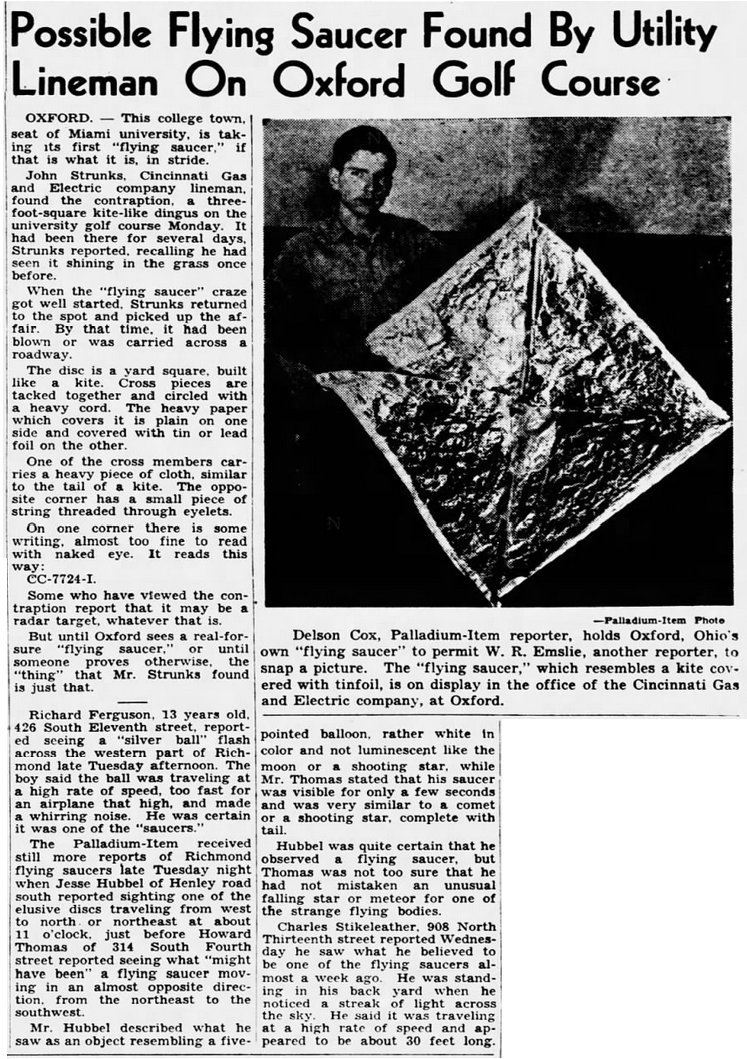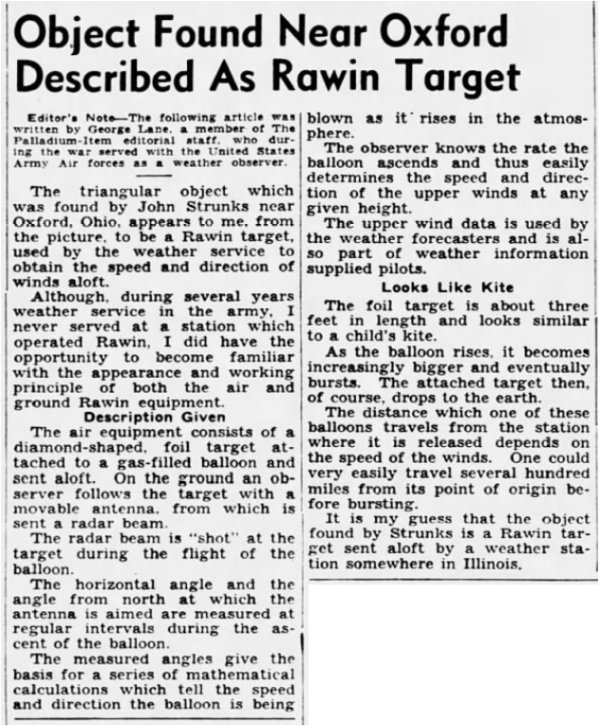
The articles below were published in the newspaper The Palladium-Item, Richmond, Indiana, USA, page 12, on July 9, 1947.

|
OXFORD. -- This college town, seat of Miami University, is taking its first "flying saucer," if that is what it is, in stride.
John Strunks, Cincinnati Gas and Electric company lineman, found the contraption, a three-foot-square kite-like dingus on the university golf course Monday. It had been there for several days, Strunks reported, recalling he had seen it shining in the grass once before.
When the "flying saucer" craze got well started, Strunks returned to the spot and picked up the affair. By that time, it had been blown of was carried across a roadway.
The disc is a yard square, built like a kite. Cross pieces are tacked together and circles with a heavy cord. The heavy paper which covers it is plain on one side and covered with tin or lead foil on the other.
One of the cross members carries a heavy piece of cloth, similar to the tail of a kite. The opposite corner has a small piece of string threaded through eyelets.
On one corner there is some writing, almost too fine to read with the naked eye. It reads this way:
CC-7724-I.
Some who have viewed the contraption report that it may be a radar target, whatever that is.
But until Oxford sees a real-for-sure "flying saucer," or until someone proves otherwise, the "thing" that Mr. Strunks found is just that.
[Photo caption:] - Palladium-Item Photo
Delson Cox, Palladium-Item reporter, holds Oxford, Ohio's own "flying saucer" to permit W. R. Emslie, another reporter, to snap a picture. The "flying saucer", which resembles a kite covered with tinfoil, is on display at the office of the Cincinnati Gas and Electric company, at Oxford.
Richard Ferguson, 13 years old, 426 South eleventh street, reported seeing a "silver ball" flash across the western part of Richmond late Tuesday afternoon. The boy said the ball was traveling at a high rate of speed, too fast for an airplane that high, and made a whirring noise. He was certain it was one of the "saucers."
The Palladium-Item received still more reports of Richmond flying saucers late Tuesday night when Jesse Hubbel of Henley road south reported sighting one of the elusive discs traveling from west to north or northeast at about 11 o'clock, just before Howard Thomas of 314 South Fourth street reported seeing what "might have been" a flying saucer moving in an almost opposite direction, from the northeast to the southeast.
Mr. Hubbel described what he saw as an object resembling a five-pointed balloon, rather white in color and not luminescent like the moon or a shooting star, while Mr. Thomas stated that his saucer was visible for only a few seconds and was very similar to a comet or a shooting star, complete with tail.
Hubbel was quite certain that he observed a flying saucer, but Thomas was not too sure that he had not mistaken an unusual falling star or meteor for one f the strange flying bodies.
Charles Stikeleather, 908 North Thirteenth street reported Wednesday he saw what he believed to be one of the flying saucers almost a week ago. He was standing in his back yard when he noticed a streak of light across the sky. He said it was traveling at a high rate of speed and appeared to be about 30 feet long.

|
Editor's note -- The following article was written by George Lane, a member of The Palladium-Item editorial staff, who during the war served with the United States Army Air forces as a weather observer.
The triangular object which was found by Joe Strunks near Oxford, Ohio, appears to me, from the picture, to be a Rawin target used by the weather service to obtain the speed and direction of winds aloft.
Although, during several years weather service in the army, I never served at a station which operated Rawin, I did have the opportunity to become familiar with the appearance and working principle of both the air and ground Rawin equipment.
The air equipment consists of a diamond-shaped, foil target attached to a gas-filled balloon and sent aloft. On the ground an observer follows the target with a movable antenna, from which is sent a radar beam.
The radar beam is "shot" at the target during the flight of the balloon.
The horizontal angle and the angle from north at which the antenna is aimed are measured at regular intervals during the ascent of the balloon.
The measured angles give the basis for a series of mathematical calculations which tell the speed and direction the balloon is being blown as it rises in the atmosphere.
The observer knows the rate the balloon ascends and thus easily determines the speed and direction of the upper winds at any given height.
The foil target is about three feet in length and looks similar to a child's kite.
As the balloon rises, it becomes increasingly bigger and eventually bursts. The attached target then, of course, drops to the earth.
The distance which one of these balloons travels from the station where it is released depends on the speed of the winds. One could easily travel several hundred miles from its point of origin before bursting.
It is my guess that the object found by Strunks is a Rawin target sent aloft by a weather station somewhere in Illinois.